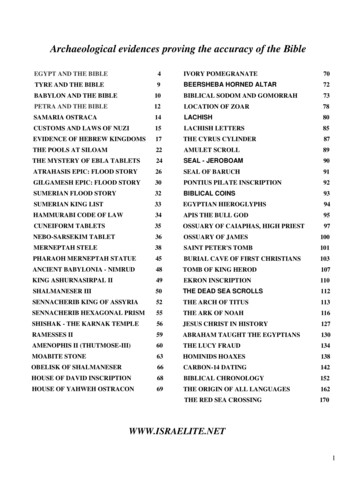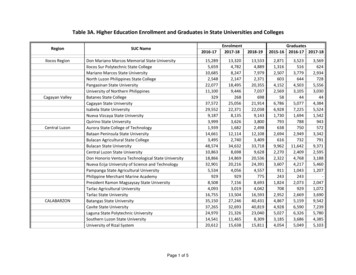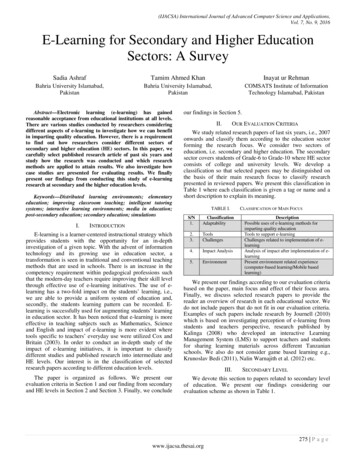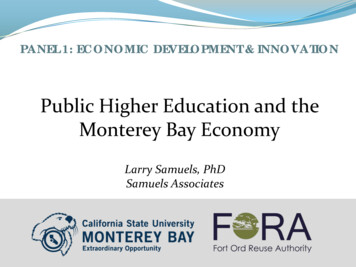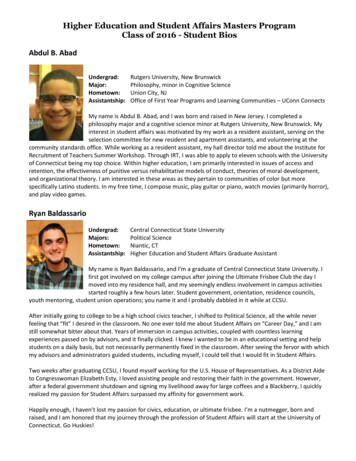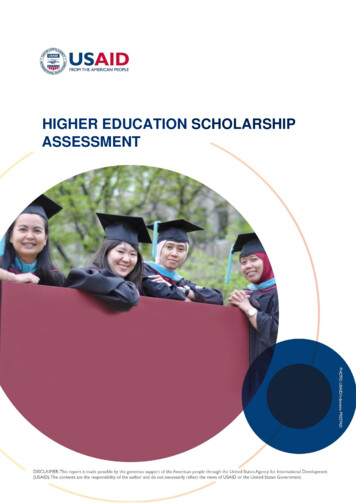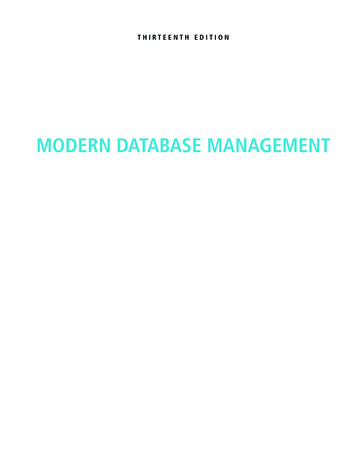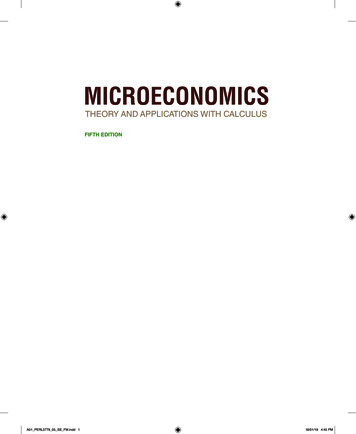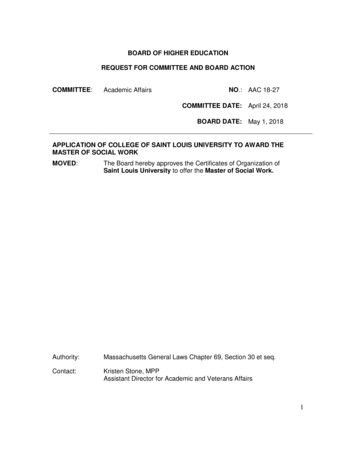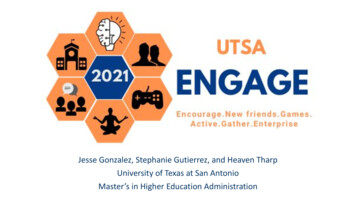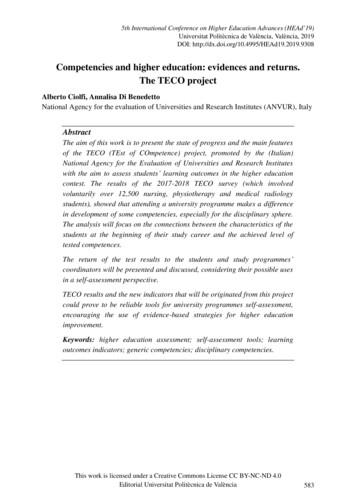
Transcription
5th International Conference on Higher Education Advances (HEAd’19)Universitat Politècnica de València, València, 2019DOI: cies and higher education: evidences and returns.The TECO projectAlberto Ciolfi, Annalisa Di BenedettoNational Agency for the evaluation of Universities and Research Institutes (ANVUR), ItalyAbstractThe aim of this work is to present the state of progress and the main featuresof the TECO (TEst of COmpetence) project, promoted by the (Italian)National Agency for the Evaluation of Universities and Research Instituteswith the aim to assess students’ learning outcomes in the higher educationcontest. The results of the 2017-2018 TECO survey (which involvedvoluntarily over 12,500 nursing, physiotherapy and medical radiologystudents), showed that attending a university programme makes a differencein development of some competencies, especially for the disciplinary sphere.The analysis will focus on the connections between the characteristics of thestudents at the beginning of their study career and the achieved level oftested competences.The return of the test results to the students and study programmes’coordinators will be presented and discussed, considering their possible usesin a self-assessment perspective.TECO results and the new indicators that will be originated from this projectcould prove to be reliable tools for university programmes self-assessment,encouraging the use of evidence-based strategies for higher educationimprovement.Keywords: higher education assessment; self-assessment tools; learningoutcomes indicators; generic competencies; disciplinary competencies.This work is licensed under a Creative Commons License CC BY-NC-ND 4.0Editorial Universitat Politècnica de València583
Competencies and higher education: evidences and returns. The TECO project1. IntroductionThe Test of Competence (TECO) project, promoted by the National Agency for theEvaluation of Universities and Research Institutes (Agenzia Nazionale per la Valutazionedel sistema Universitario e della Ricerca - ANVUR), has the aim to develop indicatorsabout the students’ learning outcomes, as part of the teaching & learning assessmentincluded in the National accreditation system (called Autovalutazione – Valutazioneperiodica – Accreditamento, AVA) of study programmes and universities. Those indicatorsare meant to be used as tools for the self-assessment activities and to inform the governanceof higher education institutions.In the following, the TECO project will be presented, as well as evidences from the last –and so far, the broader - survey (2017-2018). Finally, the return of results to theparticipating students and study programmes will be described.2. TECO project: aims and instrumentsTECO project has been developed in Italy by ANVUR since 2013. The Agency, among itsduties (established by its institutive Presidential Decree - DPR 76/2010 - and thesubsequent decrees issued by the Italian Ministry of Education, University and Research),received the mandate to define new indicators about the students’ learning outcomes, aspart of the teaching evaluation scheme that includes self-assessment, periodic evaluation,and accreditation of study programmes and universities (AVA). In this framework TECOproject aims to the assessment of students’ competences, as a proxy for the learningoutcomes.The first TECO trials, between 2013 and 2015, availed for the evaluation of Italianundergraduates’ learning outcomes of the CLA test1. These experiences bared severalshortcomings: a selection bias, weak interrater correlations and weak correlations betweenopen and closed questions rates, in addition to the high cost of the procedure (see Ciolfi etal., 2016; Damiani et al., 2016; 2017). Thus, in 2016 ANVUR revised the whole project:from the domains of assessed competences to the methodology adopted.To date, two branches of TECO have been developed, pointing toward the assessment ofgeneric (TECO-T, where T stands for trasversale) and disciplinary (TECO-D, with Dstanding for disciplinare) competencies. Generic and disciplinary competences areconceived in a broad perspective, in line with the Definition and Selection of CompetenciesThe CLA test, produced by the Council for Aid to Education (CAE), is meant to measure the students’ performance on analysisand problem solving, scientific and quantitative reasoning, critical reading and evaluation, and critiquing an argument, in additionto writing mechanics and effectiveness. It was administered twice: during 2013 in collaboration with 12 universities and during2015 in collaboration with 24 universities (see Ciolfi et al. 2016; Ciolfi & Sabella, 2017).1584
Alberto Ciolfi, Annalisa Di Benedetto(DeSeCo): «a competence is more than just knowledge or skills. It involves the ability tomeet complex demands, by drawing on and mobilising psychosocial resources (includingskills and attitudes) in a particular context» (Rychen & Salganik, 2003).Undergraduates can develop generic competencies during their university career,independently of the specific study programme. The TECO-T items are produced in houseby ANVUR, in collaboration with academic experts and in the wake of several internationalstudies2. Disciplinary competencies are conversely strictly linked to a given studyprogramme, therefore the related TECO-D are developed by working groups made up ofrepresentatives of the scientific societies of the discipline 3.A strong impulse to the project has been provided in 2017, when the progress tests alreadyused by three healthcare profession study programmes (Nursing, Physiotherapy andMedical radiology) voluntarily underwent a validation analysis by ANVUR and asubsequent item revision, to be adopted as three different TECO-Ds (one for eachprogramme). From late 2017 until early 2018, the TECO-D of these three studyprogrammes was delivered to about 12,500 students from 27 Universities4.Accordingly to the main purposes of the project, the value-added approach has beenadopted – whereby both the competences of ingoing (first-year students) and outgoing(third-year students) first cycle university students are assessed. In perspective, eachcoordinator of a study programme should consider not only its students’ absolute results incomparison with those achieved by students from other universities, but also, and moreinterestingly, the change occurred from the initial conditions.2For instance: the Six Subject Survey, the Progress in International Reading Literacy Study (PIRLS), the Trends in InternationalMathematics and Science Study (FIMMS and TIMSS), the International Civic and Citizenship Education Study (ICCS) endorsedby the International Association for the Evaluating of International Achievement (IEA); the Programme for International StudentAssessment (PISA) and the Programme for the International Assessment of Adult Competences (PIAAC), by the Organisation forEconomic Co-operation and Development (OECD). Should also be considered the Assessment of Learning Outcomes in HigherEducation (AHELO), dedicated to learning outcomes in higher education.ANVUR supervises each TECO-D working group’s activities and provides dedicated methodological and technical support. Allthe TECO tests undertake a validation procedure, including at least one field trial. The commitment in the project is voluntary.34A total attendance of 12.510 students, of whom 3.993 (31.9%) carried out the paper and pencil version of the test rather than onthe online platform managed by CINECA, an interuniversity consortium that offers support to the research activities throughsupercomputing and its IT applications.585
Competencies and higher education: evidences and returns. The TECO project3. Evidences on competencies development in higher educationThe 2017-2018 TECO survey, involving students enrolled in Nursing, Physiotherapy andMedical radiology programmes in different universities across the Country, is by far thelargest assessment of university students’ competences accomplished in Italy to date. Inaddition to one of the three available TECO-Ds, each of the participants performed also twogeneric competences tests5: Literacy and Numeracy.Literacy items6 are meant to evaluate the undergraduates’ levels of understanding andreflecting competencies on a text with a generic content. Numeracy items7 assessundergraduates’ levels in logical thinking and solving quantitative problems. Genericcompetencies scores were calculated considering all the participants’; disciplinarycompetencies scores were calculated separately for each TECO-D8.The participation to the 2017-18 survey was less extensive for the Nursing programmes,which have usually more students and different locations per programme (see Table 1).Table 1. Participation to the 2017-18 TECO survey: performed tests by year and discipline,total number of students enrolled in the participating programmes, participation ratePerformed testsEnrolled studentsPartecipation rate1 year2 year3 siotherapy5855136591,7572,68065.6%Medical radiology3302213509011,28170.3%The following analysis focus on the connections between the identified competences andthe characteristics of the students at the beginning of their university studies. In order toreduce the risk of distortions, these analyses consider only the first-year students enrolled in2017-2018 and the third-year students enrolled in 2015-2016, who have completed all thethree parts of the TECO: Literacy, Numeracy and one of the TECO-D (Table 2).5For two others ambits the design process was ongoing. At present, the frameworks of Problem Solving (see ANVUR, 2019), andCivics tests have already been defined, with the items of the former to be validated in spring 2019.6The test contains two types of items: the former require participants to complete 10 closed-answer questions after reading a text,in the latter they have to complete a short text with 20 words that are missing (Cloze test), for a total of 30 items.7This test provides for a short text that includes graphs and tables, followed by five questions, an infographic followed by fivequestions, and 15 short logical reasoning questions, for a total of 25 items8Two parameter IRT models were used. All the scores are standardized on a scale with mean 200 and standard deviation 40, tosimplify the comparison.586
Alberto Ciolfi, Annalisa Di BenedettoTable 2. Complete tests by year and discipline, for the first-year students enrolled in 2017-2018and the third-year students enrolled in 2015-20161 year3 807Medical radiology241228469Total4,8482,2387,086Finally, the methods for returning the TECO results to the participating students and tostudy programmes’ coordinators will be presented, discussing the possible uses in a selfassessment perspective.3.1. Generic competenciesFrom an analysis by cohort, the outcomes on generic competences appear to be narrow butsignificant (Figure 1; for a more broad analysis see Ciolfi & Sabella, 2018).Figure 1. Generic competences scores: mean and confidence interval ( ̃ std.err.) by enrollment yearIt is worthy to consider the generic competences in the light of the characteristics of thestudents at the beginning of their university studies. Further, the disciplinary competencewill be examined from the same perspective. The regression models in Table 3 contemplateas possible explicative factors the enrolment year, the gender, the age, the type of highschool attended (School of origin), the high school’s final grade and the social-culturalstatus9.9Social-cultural status index, inspired to the Economic, Cultural, and Social Status (ESCS) used in the OECD-PISA reports (evenif without the home possession dimension). It is obtained using a principal component analysis on the parents’ higher occupational587
Competencies and higher education: evidences and returns. The TECO projectSome of these evidences could lead to a cumulative advantage hypothesis (“the rich getricher, the poor get poorer”)10, which however would require a more detailed study onlongitudinal data by cohort. The effect of the enrolment year is accompanied by othersignificant effects related to the gender and the previous education studies (for Numeracy,the social-cultural status also).Table 3. Regression models for Literacy and Numeracy scores by: enrolment year, gender, age,school of origin, final grade and social-cultural status – coefficients, sig., N. and R-squaredLiteracyNumeracyEnrollment year3/18,570***8,791***GenderFemale / Male-4,598***-3,412***Age20-21 / under 19-1,531-3,412*22-23 / under 19-0,022-6,277**over 24 / under 19-1,66-9,589***School of originHigh school / Tecnical school8,129***8,696***School final gradeHigh / N4.5844.584R-squared0,03450,0624Social-cultural statusConstant*p .05, **p .01, ***p .0013.2. Disciplinary competenciesThe effect of university studies on disciplinary competences results significant and far moreconsistent, if compared with the effect on the generic competences scores (see Figure 2).status (scored according to Ganzeboom & Treiman, 1996) and the parents’ higher number of year of instruction (the proportion ofvariance explained by the extracted component is 70.7%).10This hypothesis would diverge from earlier works concerning the TECO administration of the CLA test (Ciolfi & Sabella,2017).588
Alberto Ciolfi, Annalisa Di BenedettoFigure 2. Disciplinary competences scores: mean and confidence interval ( ̃ std.err.) by enrollment yearThe regression models in Table 4 point out, besides the relevance of the enrolment year,also the lack of significance of almost all the other factors, with few exceptions (i.e. schoolfinal grade and age for Nursing; school final grade and gender for Medical radiology).These results are extremely encouraging, especially considering the wide effect of highereducation studies, regardless of the students’ characteristics at the beginning of their course.As mentioned above, the TECO-D for nursing, physiotherapy and medical radiology studyprogrammes were delivered because the corresponding working groups were the first tojoin the project. Currently, other disciplinary working groups, such as literature,philosophy, pedagogy, psychology started developing a TECO-D.589
Competencies and higher education: evidences and returns. The TECO projectTable 4. Regression models for the disciplinary scores by: enrolment year, gender, age, school oforigin, final grade and social-cultural status – coefficients, sig., N. and R *70,159***66,482***-2,0782,989-7,898*20-21 / under 194,577***4,9897,31822-23 / under 190,9674,012911,411over 24 / under 193,632*4,01311,01School of originHigh school / Technical school-0,9081,0430,708School final gradeHigh / 66490,6079Enrollment year3/1GenderFemale / MaleAgeSocial-cultural statusConstant*p .05, **p .01, ***p .0013.3. Return of TECO resultsThe results of each TECO survey are made available to all attending students and theirstudy programmes’ coordinators. Students receive, on request, their personal resultstogether with clear reference points to compare them (i.e. the mean score obtained bystudents with a similar profile). The certificate of attendance presents, for Literacy andNumeracy TECO-T: the score obtained the average score of students of the sameenrollment year, the average score of students of the same enrollment year and university.For the TECO-D, the row score by topic is presented, along with the reference averages.590
Alberto Ciolfi, Annalisa Di BenedettoTable 5. Overall reference data for the participating programmes, simplified example tablecontaining only the average score per cohort and study programmeNursingPhisioterapyLit.Cohort*Lit.Num. Disc.Num.Disc.1 year, enrolled before 2016208208,8 175,9 181,2 154,3 176,4 215,2238,8191,3166,4 210,2224,8134,1194,8 195,3 175,3 205,9210,6163,2--1 year, enrolled in 2016207,7 223,3 167,6 188,21 year, enrolled in 2017206,2 220,1159Num. Disc.Medical radiology1922 year, enrolled before 2015 189,7 213,7 204,5 187,4 195,1 216,9Lit.-2 year, enrolled in 2015209,8 227,7 215,7 179,3 175,4 211,5 211,1220,6179,12 year, enrolled in 2016209,6 225,9 207,9 190,7 193,7 221,2222,1196,72073 year, enrolled before 2014 206,6 210,3 231,3191190,9 241,6 204,6203,82193 year, enrolled in 2014209,6 212,4 236,6197191,6 242,1 217,4226,7241,63 year, enrolled in 2015207,7 220,2233197,7 194,5213,8225,8232,3Total206,9 219,4203191,9 190,7 207,6210221,2201,1236*Cohorts that include too few students are obscured out for privacy protection reasons.Regarding the return of results to study programmes, the goal is to give useful informationfor self-assessment purposes. Each university receives its own microdata (suitablyanonymized and obscured to prevent the identification of students) and a table presentingthe overall reference data. The latter are referred to all the participating programmes and arepresented by cohort and study programme: the average scores for each competence tested,the average number of correct answers for each thematic area of the disciplinary test andthe total number of attendees (see as a simplified example – containing only the averagescores – Table 5) are made available.4. Conclusions and remarksThe attendance to a university study programme makes a difference in the development ofsome competencies, especially for the disciplinary sphere. TECO project results could bereliable tools for university programmes self-assessment, to be used for evidence-basedstrategies in higher education improvement.The return of the TECO results aims at helping the programmes’ coordinators to initiate ordeepen the reflection about the generic competence development, by providing a broaderinformation framework on the profile of their students. The project intends to contribute to591
Competencies and higher education: evidences and returns. The TECO projectthe analysis of the strengths and weakness of the offered disciplinary training, helping thereflection on the possible improvement interventions, with respect to the planning andimplementation of the programmes.ReferencesANVUR (2019). Il problem solving come competenza trasversale: inquadramento eprospettive nell'ambito del progetto TECO, Scuola Democratica, 1/2019, (in press).Ciolfi, A., Damiani V., Delli Zotti, F., Sabella, M. (2016). La sperimentazione sullavalutazione delle competenze attraverso il test sulle competenze (TECO – 2013 e2015)», in ANVUR, Rapporto sullo Stato del Sistema Universitario e della Ricerca2016, Roma, ANVUR, pp. 259-287.Ciolfi, A., Sabella, M. (2017). Assessing resilience at University. In Proceedings of the 3rdInternational Conference on Higher Education Advances (pp. 1104-1112). EditorialUniversitat Politècnica de València.Ciolfi, A., Sabella, M. (2018). La rilevazione delle competenze degli studenti: il progettoTECO, in ANVUR, Rapporto sullo Stato del Sistema Universitario e della Ricerca2018, Roma, ANVUR, pp. 155-166.Damiani, V., Agrusti, F., Ciolfi, A. (2016). Le prove a risposta aperta della sperimentazioneTECO 2015: esplorazione dell’archivio testuale. CADMO, Volume 24, Issue 2, 2016,pp. 105-111; ISSN: 1122-5165.Damiani, V., Agrusti, F., Ciolfi, A. (2017). Argomentare all’università. Un’analisi delleprove a risposta aperta della sperimentazione TECO 2015; CADMO, 1, 2017; ISSN1122-5165.Rychen, D. S., Hersch, S. L. (Eds) (2003). Key Competencies for a Successful Life and aWellFunctioning Society. Cambridge, MA: Hogrefe & Huber.592
TECO results and the new indicators that will be or iginated from this project could prove to be reliable tools for university programmes self -assessment, encouraging the use of evidence -based strategies for higher education improvement. Keywords: higher
